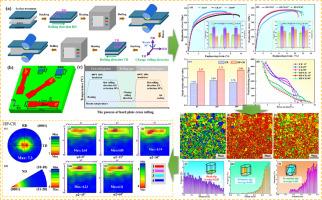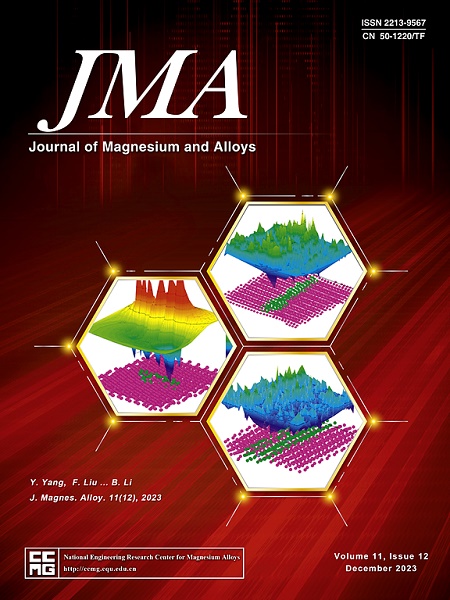Texture traits and mechanical anisotropy of AZ31 magnesium alloy sheet by hard plate cross rolling
IF 15.8
1区 材料科学
Q1 METALLURGY & METALLURGICAL ENGINEERING
引用次数: 0
Abstract
Conventional cross rolling is influenced by the force couple effect of symmetrical rollers, resulting in the c-axis of the plate grains being oriented perpendicular to the rolling surface. This orientation contributes to a high degree of work hardening and mechanical anisotropy, thereby complicating subsequent processing. In this study, the hard plate cross rolling (HP-CR) process is put forward for the first time, and the microstructure evolution and mechanical properties of rolled AZ31 Magnesium plate were analyzed. The results indicate that, in comparison to traditional cross rolling (CR), the average grain size of the HP-CR is refined to 5.33 µm. Additionally, the average yield strength and elongation of the sheet are enhanced by 15.2 % and 35.2 %, respectively, while the average tensile strength is 283 MPa, and the r value decreases by 39.8 %. These changes are attributed to the combined effects of grain refinement, microstructural homogenization, and basal texture weakening. On the one hand, the substantial energy stored in the original lattice distortion serves as a driving force for the dynamic recrystallization process, facilitating the elimination of the deformed grain structure. This process increases the proportion of recrystallized grains from 5 % to 82 %, reduces the degree of work hardening, and correspondingly decreases the density of geometrically necessary dislocations (ρGND) by 70.8 %, accompanied by the formation of high-angle grain boundaries (HAGB). On the other hand, dynamic recrystallization promotes grain rearrangement, resulting in an increased number of grains oriented in the transverse direction (TD), which diminishes the texture strength of the basal plane. Concurrently, the activation of non-basal slip systems reduces the resistance to dislocation sliding in various directions, significantly reduces the degree of mechanical anisotropy and enhancing the plastic deformation capacity of the plate. This research provides valuable scientific insights and technical foundations for the large-scale manufacturing of high-performance AZ31 magnesium alloy sheets.

求助全文
约1分钟内获得全文
求助全文
来源期刊

Journal of Magnesium and Alloys
Engineering-Mechanics of Materials
CiteScore
20.20
自引率
14.80%
发文量
52
审稿时长
59 days
期刊介绍:
The Journal of Magnesium and Alloys serves as a global platform for both theoretical and experimental studies in magnesium science and engineering. It welcomes submissions investigating various scientific and engineering factors impacting the metallurgy, processing, microstructure, properties, and applications of magnesium and alloys. The journal covers all aspects of magnesium and alloy research, including raw materials, alloy casting, extrusion and deformation, corrosion and surface treatment, joining and machining, simulation and modeling, microstructure evolution and mechanical properties, new alloy development, magnesium-based composites, bio-materials and energy materials, applications, and recycling.
 求助内容:
求助内容: 应助结果提醒方式:
应助结果提醒方式:


